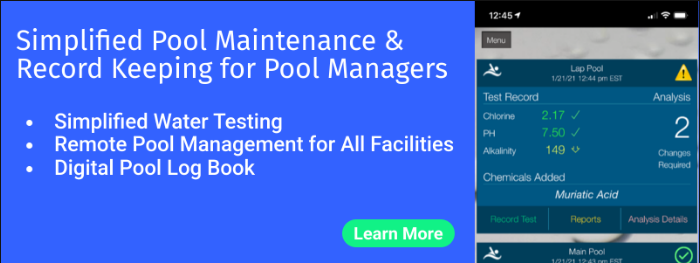Whether you operate a “traditional” pool or a saltwater pool, you likely think of your disinfectant (typically chlorine) as your hero pool chemical. But the truth is, while yes, you absolutely have to have chlorine in the ideal range in order to disinfect and kill all the potentially harmful microorganisms and substances, pool chemistry is complicated. All parameters and chemicals, from pH to calcium hardness, need to be in balance in order for chlorine to effectively do its job.

This includes cyanuric acid (CYA), often referred to as a chlorine stabilizer or pool stabilizer. It plays an important role in protecting chlorine from degradation by the sun’s ultraviolet rays; if you operate an outdoor pool, it’s just as critical to your water chemistry as chlorine.
However, too much of it can create serious problems. If CYA levels climb too high, it will reduce chlorine's effectiveness and compromise water quality, creating something called “chlorine lock.”
Let’s take a closer look at the symptoms of elevated cyanuric acid, what commercial and public pool operators should watch for, and how to fix and prevent this issue.
What Is Cyanuric Acid and Why Is It Used?
As we mentioned, cyanuric acid is commonly added to outdoor pools to stabilize chlorine, helping it stay active longer under direct sunlight. This is particularly important in large, high-use environments like public pools, where maintaining consistent chlorine levels is critical. Ideally, CYA levels should stay between 30 and 40 ppm for most pools. For indoor facilities, CYA should not be used at all.
However, the same compound that protects chlorine can become a liability when levels exceed recommended ranges. In public and commercial settings, this imbalance can quickly affect both water quality and swimmer safety.
Signs Your Pool Has Too Much Cyanuric Acid
When CYA levels are too high, you’ll likely notice some clear, and some subtle, signs. These symptoms often resemble other chemical imbalances, so it's important to regularly test your water to confirm the cause. Here are the most common red flags:
Chlorine Isn’t Doing Its Job
The most significant issue with high CYA is that it binds to free chlorine in the water. CYA doesn’t degrade like chlorine, so when there’s too much, it essentially “locks up” chlorine, making it much less effective at killing bacteria and other harmful pathogens. This can leave your pool looking fine on the surface, but with insufficient sanitation, the water could actually pose health risks.
Persistent Cloudy Water
If your pool water is consistently cloudy or murky despite regular maintenance, high CYA could be part of the problem. Since chlorine isn’t as effective, organic debris and microscopic particles aren’t broken down properly, resulting in a dull or murky appearance.
Recurring Algae Problems
Is algae popping up more often than usual, even after shock treatments or deep cleanings? That’s a major clue you have elevated cyanuric acid levels. High CYA levels also weaken chlorine’s ability to prevent algae growth, leading to increased maintenance needs and higher chemical costs.
Slow Response to Chemical Adjustments
If you’ve noticed that correcting your pool chemistry takes more time or product than it used to, your pool stabilizer could be interfering. When it's too high, it affects the performance of other chemicals in addition to chlorine and can throw off your pH and total alkalinity levels as well.
Why High CYA Is a Bigger Problem in Public and Commercial Pools
In a residential pool, minor chemical imbalances might go unnoticed or pose minimal risk. But in high-bather-load environments like public pools, hotels, or aquatic centers, these issues escalate quickly.
Excessive CYA contributes to:
- Reduced water safety: Ineffective sanitation allows bacteria, viruses, and parasites (like Cryptosporidium) to survive longer.
- Increased maintenance costs: You'll end up using more chlorine and other chemicals to try to achieve the same sanitizing power. You may end up needing higher chlorine levels in the water than the state health department allows to stay open (10 ppm)
- Operational challenges: Water clarity issues and algae growth can result in the need to close your facility, or drop other responsibilities to handle unscheduled maintenance.
How to Lower Cyanuric Acid Levels
Elevated cyanuric acid levels can silently compromise your entire pool operations–but don’t panic yet. Fortunately, there are a few proven strategies to bring CYA levels back down:
Dilute Through Water Replacement
The most common and effective method is draining and replacing part of the pool water with fresh water. This dilutes the cyanuric acid concentration. Depending on your levels, you might need to replace 25–50% (or more) of the water. While this can be time-consuming and costly, it's often the fastest way to restore balance. Pro Tip: never drain the pool completely as this can cause the pool to ‘pop’ out of the ground if done incorrectly.
Switch to Unstabilized Chlorine
Many commercial operators use stabilized chlorine products like trichlor or dichlor, which contain built-in cyanuric acid. However, you likely don’t need to be adding more pool stabilizer as often as you need to add more chlorine. CYA doesn’t degrade in the water, and using stabilized chlorine tablets is often the fastest way to elevated CYA levels.
If you’re battling high CYA, it may be time to switch to unstabilized chlorine options like liquid chlorine (sodium hypochlorite) or calcium hypochlorite. These do not add more CYA to your water. Adding pool stabilizer separately from chlorine gives you more control over your levels of each. When using separate pool stabilizer, you can typically expect to add it once per year, at the beginning of pool season. It’s also a good idea to test levels following high volume days, such as the 4th of July, large pool parties, and storms–as large volumes of swimmers can use up chlorine faster while large rainfall can dilute pool water.
Use a Cyanuric Acid Reducer
There are products on the market that claim to reduce CYA biologically or chemically. These tend to work slowly and may require specific water conditions to work. Results can vary, and potentially be costly so check manufacturer guidelines and test carefully. Not recommended.
Stay on Top of Testing
Regular testing is your best defense. Cyanuric acid levels testing should absolutely be part of your routine water analysis, especially during the summer months or high-use periods.
- Train staff regularly on water chemistry and the importance of pool stabilizer management. Ensure you employ a certified pool operator on staff who has been trained on the complex balance of pool water chemistry.
- Educate facility users about pre-swim hygiene to reduce organic load and chlorine consumption.
- We recommend using a digital pool log like PoolShark H2O to log test results, provide chemical adjustments, identify trends early, and manage the complex chemical math equations for you..
Final Thoughts
Cyanuric acid plays a valuable role in pool maintenance, but like most things, balance is key. When CYA levels rise too high, chlorine loses its effectiveness—putting water quality, safety, and your pool’s reputation at risk. You’ll also see similar issues arising when CYA levels are too low. In commercial and public pool settings, the consequences of this imbalance can be costly, both financially and operationally.
By staying proactive, regularly testing your water, and understanding the symptoms of high CYA, you’ll be well equipped to maintain safe, sparkling water all season long.
That said, the calculations to keep CYA and free chlorine levels correct and in balance can be complex and time-consuming. It’s why we built the Pool Shark H2O app: instantly, it does all the chemical calculations for you, telling you exactly how much CYA and other chemicals to add, ensuring safety, balanced water, and lower chemical costs.
When paired with the LaMotte WaterLink Spin Touch, testing is complete within 60 seconds to a high degree of accuracy.
Tests and chemical logs are also digitally recorded and locked, setting you up for easy Health Department compliance, and making it easy for managers to check tests, logs, and alerts remotely, for multiple properties.



